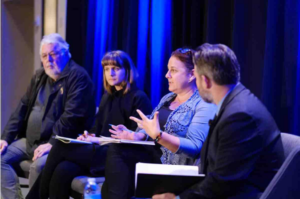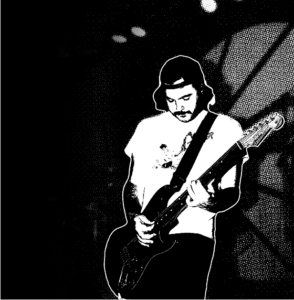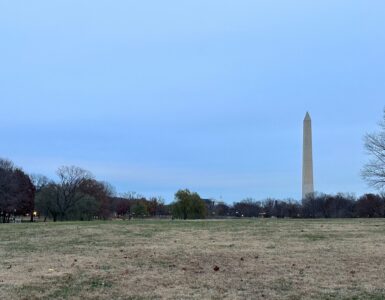By Lia Faenza
Streaming has revolutionized how people access music, but it has also created significant financial challenges for independent and smaller artists. Platforms like Spotify, Apple Music and YouTube Music dominate the industry, but their payouts per stream vary. According to data from VIRPP, Tidal pays $0.0125 per stream, Apple Music about $0.0075, and Spotify a mere $0.003.
For less popular artists, these fractions of a cent per stream are rarely enough to cover basic costs, forcing them to rely on other revenue sources like live performances and merchandise to survive. Will Teague, guitarist and vocalist for the Baltimore-based grunge band Dosser, illustrates this reality.
“At this point, the band basically pays for itself,” he said in a Zoom interview. “But to pay my bills — my mortgage, car payment, and phone bill — I still have to have a day job.” Teague works freelance in IT, describing his role as “helping a lot of boomers with their passwords and printers.” He balances his creative ambitions with the demands of additional work to sustain his livelihood.
Streaming services have become the primary way people consume music, replacing physical album sales and digital downloads. And, experts say, reshaped the industry’s revenue model. “Streaming models have turned traditional album sales on their head,” said Linda Bloss-Baum, the program director for American University’s Business and Entertainment program, in a Zoom interview.
 This shift began in the early 2010s as platforms like Spotify and Apple Music gained popularity for their extensive catalogs and ease of use. Listeners now have access to millions of songs for a flat monthly fee, a model that has reshaped the music industry’s economy. While convenient for consumers, this transformation has changed how artists are compensated, with revenue now based on streams rather than purchases.
This shift began in the early 2010s as platforms like Spotify and Apple Music gained popularity for their extensive catalogs and ease of use. Listeners now have access to millions of songs for a flat monthly fee, a model that has reshaped the music industry’s economy. While convenient for consumers, this transformation has changed how artists are compensated, with revenue now based on streams rather than purchases.
Previously, artists earned significant revenue from selling physical albums or digital downloads, but streaming has created a microtransaction-based system. This shift has also affected how artists present their work. “Albums represent a segment of [an artist’s] life,” Bloss-Baum explained. “It’s really hard to do that in a single universe because you’re only releasing your thoughts and feelings three minutes at a time.” For independent artists, competing for attention in a single-centric, crowded market adds another layer of difficulty.
The global reach of streaming further complicates the challenges for artists. Platforms negotiate deals with major labels, publishers, and independent distributors, often prioritizing larger entities with greater bargaining power. Smaller artists and labels frequently receive less favorable terms and lower payouts. Competition for visibility is intense, as the vast pool of music makes it harder for independent musicians to stand out without significant promotional resources. As a result, the largest players in the industry — both artists and labels — capture the majority of financial benefits, leaving smaller artists struggling to sustain their careers.
The pro-rata royalty model most streaming platforms use compounds these challenges. Under this system, revenue from all subscribers is pooled and distributed based on total streams, favoring artists with large audiences. According to Bloss-Baum, the user-centric model offers a fairer approach. She explained, “If you’re a fan who only listens to independent artists, all of your $10 subscription fee would go to those artists.” Despite its potential, this model has seen little adoption, leaving independent artists at a disadvantage.

Independent musicians also face systemic obstacles in negotiating fair rates with streaming platforms. Jen Jacobsen, executive director of the Artist Rights Alliance, pointed out in a Zoom interview that antitrust laws prevent independent artists from bargaining collectively. “Small musicians can’t actually negotiate alongside other musicians,” she said.
To address this, Jacobsen’s organization helped draft the Protect Working Musicians Act, which seeks to allow independent artists to negotiate as a group with dominant platforms like Spotify and Amazon Music. While the bill faces an uphill battle, Jacobsen believes it has already made an impact. “Sometimes you support [a bill] not because you think it can pass immediately, but because it sends a message… pointing out what inequities there are in the current system.”
Teague knows these inequities firsthand. Despite Dosser gaining popularity, now with about 13,000 monthly Spotify listeners, and securing spots on Spotify’s editorial playlists, he says the streaming payouts remain underwhelming. “Even if you make it this far, you can’t rely on that. It’s only… a couple hundred bucks here and there,” he said.
Like many independent musicians, Dosser relies on live performances and merchandise sales to fund their work. “The money we’re spending on recording is money we raised through playing shows and selling merch,” Teague added, underscoring how streaming rarely contributes directly to their personal income.

For some artists, platforms like Bandcamp offer a glimmer of hope. Bandcamp allows musicians to sell music directly to fans, keeping a larger share of profits. “Bandcamp Fridays, where bands keep 100% of profits, are great,” Teague said.
Still, Bloss-Baum cautions against relying on Bandcamp alone: “You also want to make sure that you’re on every single platform… you can’t rely just on the Bandcamps of the world.” Bandcamp’s audience is much smaller than that of Spotify or Apple Music, limiting its potential as a primary income source.
Legislative efforts have sought to address these challenges. The Music Modernization Act of 2018 helped streamline mechanical royalty payments, but Jacobsen says gaps remain. “We’re starting to see initiatives to try to get more efficiency… but it’s a slow process,” she said.
For some, a promising development is the Protect Working Musicians Act’s focus on combating the unfair use of artificial intelligence in music. The act seeks to prevent AI systems from exploiting artists’ work without proper compensation or consent, reflecting growing concerns about the ethical and economic implications of generative AI.
Jacobsen sees these protections as part of a broader push for fairness, ensuring artists maintain control over their creations and receive appropriate compensation in an evolving industry. “Artists deserve to get some government funding if they are adding to the culture and economy of a country,” she says, underscoring the importance of strong legislative safeguards.
Steven Ambers, a certified public accountant who has focused on royalty consulting, highlighted how innovations like TuneCore have democratized distribution, enabling independent artists to release music without traditional labels. “Today, you can record a high-quality album in your home,” he explained in an interview, referencing how technology has eliminated barriers like expensive studio costs.
However, Ambers warns that streaming has made the industry more corporate. “In the past, labels invested in artists and gave them time to find their audience. Today, if you don’t have an immediate hit, you’re out,” he says.
The disparities in streaming payouts highlight the systemic challenges independent artists face. As illustrated by the graph, platforms like Spotify offer the lowest payouts but dominate the market due to their vast user bases. Tidal and Apple Music, which provide higher per-stream rates, struggle to compete on scale. This forces artists to prioritize platforms with larger audiences, perpetuating the inequities in how royalties are distributed.
To overcome these challenges, Jacobsen stresses the importance of education. “Knowing what’s out there is the very first step to making sure you’re protected,” she said. She recommends that artists register their works, join organizations like the Mechanical Licensing Collective, and take advantage of resources offered by advocacy groups.
As Jacobsen puts it, “Artists deserve a seat at the table. Their voices are the foundation of this industry, and they must be heard.”















[…] Spotify had instituted a policy not too long ago where if a song does not reach 1000 streams, the artist will not get paid. That means that if you had a song with 999 streams at the end of the year, YOU GET NOTHING. They claim that this is done because tracks with under 1000 plays make so little money. Why is that I wonder? […]
[…] Spotify had instituted a policy not too long ago where if a song does not reach 1000 streams, the artist will not get paid. That means that if you had a song with 999 streams at the end of the year, YOU GET NOTHING. They claim that this is done because tracks with under 1000 plays make so little money. Why is that I wonder? […]
[…] It’s impossible to ignore streaming platforms: they’re the entry point for many listeners and a source of ongoing royalties. However, the payout per stream is low, especially for indie artists, so you’ll need volume and strategy. For example, streams alone are rarely sufficient for making a living. The Wash+1 […]